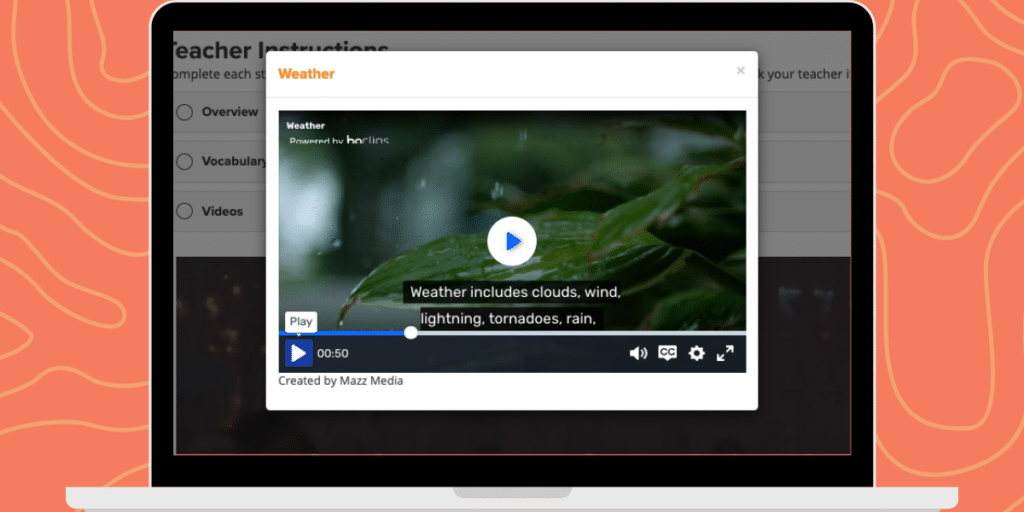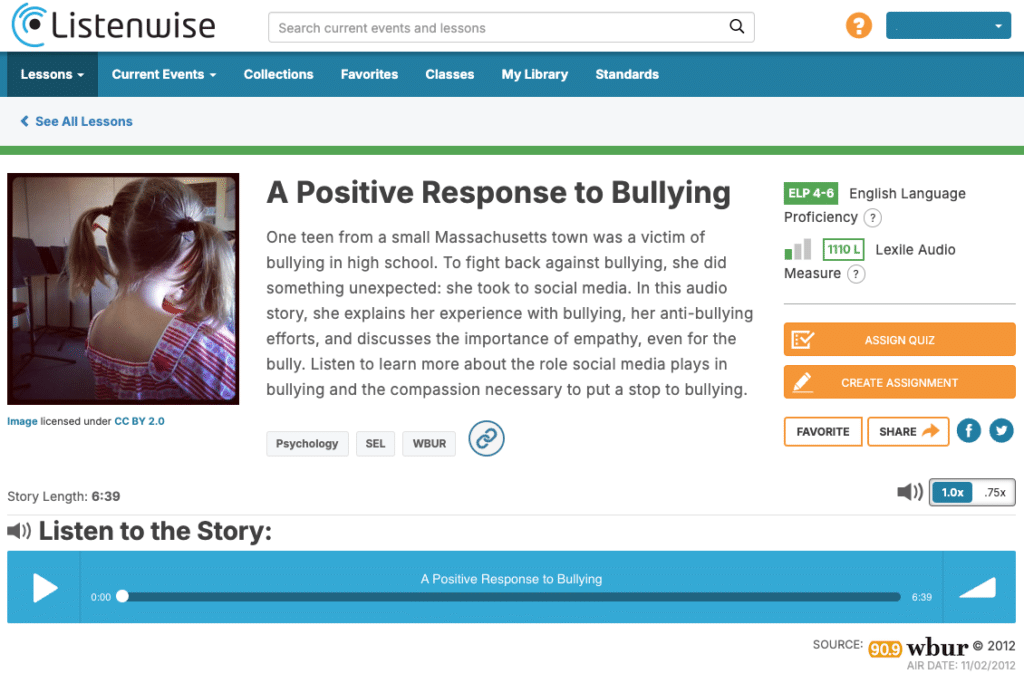Last Updated on November 15, 2024
The following is a guest post about using Listenwise lessons to teach executive functioning skills to middle school students who struggle with listening comprehension.
Chelsea Adams is a Speech-Language Pathologist at Einstein Middle School in Shoreline, WA. This is her eleventh year of being a school-based SLP, and she has found that middle schoolers are eager to learn about their brains! When not working with students, Chelsea is a bookworm who enjoys spending time outdoors with her family in the Pacific Northwest.
As a Speech-Language Pathologist, I receive many referrals from concerned teachers about students’ listening comprehension skills. The students I work with typically have difficulty summarizing what they’ve read or listened to in the classroom, and in turn, struggle to retain new content from day to day.
I realized I needed to learn more about the missing link in students’ learning: executive functioning (EF). Executive functioning refers to the cognitive processes that are responsible for the organization of thoughts and activities, prioritizing tasks, self-monitoring, decision-making, time management, and more.
To learn more about executive functioning, I sought out information from a variety of sources, including: Tera Sumpter’s online community, Seeds of Learning, research from Russell Barkley, PhD; Amishi Jha, PhD’s book “Peak Mind” (2021); and Kelly Cartwright’s book “Executive Skills and Reading Comprehension” (2023). Over time, I began to see the connection between executive functioning skills (e.g., attention, inhibition, working memory, planning, self-monitoring) and student learning and language. It also became clear that I needed to put this information into the hands of those who needed it most: the students.
Teaching Executive Functions to Students
I explain executive functioning to my students by borrowing Tera Sumpter’s analogy: their EF system is like an orchestra conductor, helping to ensure all the different instruments (parts of the brain) are playing in harmony. Without the conductor, the instruments might play out of sync, making it difficult to produce a beautiful piece of music. Similarly, without strong executive functioning, it can be hard to focus, plan, or organize your thoughts.
Each week, I prepare a lesson focused on a strategy to help students strengthen their EF skills, which they practice with a Listenwise audio story. Both students and staff are starting to use common language for the EF strategies learned during Listenwise lessons. And, the benefit of using Listenwise is that the lessons can be brought to life by adding visuals, short video clips, or hand-selecting stories that relate to classroom themes or book studies.

All Listenwise stories come with a variety of supports, including multiple visuals

Listenwise’s ELD lessons come with paired videos for building background
Students learn about their brain, their individual executive functioning strengths and areas for growth, and get to explore new parts of the world, new people, and new concepts through the audio stories.
Example: Building Working Memory
Here is an example of how I introduce working memory as the area of focus and how I support its development with a Listenwise story.
First, I review the six areas of executive functioning that my students have been working on and highlight the day’s specific area of focus — in this case, working memory.

Next, I’ll introduce a strategy for developing the target skill, starting with the “Talk it Out” strategy. With permission from Tera Sumpter, SLP, I incorporate her visuals to reinforce the concepts. My students used “Talk it Out” to complete the learning cycle – recognizing the input as being a Listenwise story and the output being their generated summaries.

Visuals Credit: Tera Sumpter, SLP
Students learn that through the process of summarizing (in any modality), new information sticks in their brain. If we don’t have a form out of output, we aren’t able to Complete the Circuit, and therefore the new learning falls away. By using a Listenwise lesson with reading, listening, and watching components, and using talking as an output, we’re completing the circuit necessary for learning.
I then provide students with a variety of outlines to encourage brief note-taking while listening to the audio stories. They learn that the process of note-taking supports their working memory, and in turn, they are able to summarize more accurately and completely.

I introduce visuals of how this process works and give students an opportunity to take responsibility for their own development so they can learn EF skills that can be applied in school and beyond.
Using Listenwise to Support Building Working Memory
One of my favorite things about Listenwise is that there are so many lessons on a diverse range of topics. No matter what your students’ interests are, there are likely a few stories on that topic. Here are some Listenwise lessons that my students and I have particularly enjoyed:
- Video Game Inspires Teen’s Love of Nature
- Debate: Should Breakdancing Be an Olympic Sport?
- Vampire Bats
- Teen Cyclist Reflects on His “Impossible Feat”
To show how I take a lesson and apply tools to build working memory, here’s an example using the Listenwise lesson, “A Positive Response to Bullying” (available in gen ed and ELD versions).

As I already introduced to my students in the “Why Talk It Out?” slide, learning how to take quality notes to produce good summaries, that preserve the most important aspects of the meaning of texts or source material, is a critical step to supporting working memory and synthesis of information.
I created a simple document to support my students in learning how to be skilled comprehenders: the outline guides them in writing down important keywords as they listen to the story and then serves as a prompt to get conversations started as they “Talk it Out” (i.e., summarize) with their classmates. These benchmark check-ins are natural opportunities for students to self-monitor their comprehension and practice self-advocacy skills as well.

Students may ask, “Can you replay the last part, I didn’t understand that word?” or “What did they mean when they said this?”
I encourage my students to be asking these types of clarifying questions because self-monitoring is a crucial executive functioning skill. These clarifying questions demonstrate their engagement, attention, and ability to identify what they don’t know yet.
Another fantastic embedded resource I use during lessons are Listenwise’s customizable listening comprehension questions. Here are the questions included in the “A Positive Response to Bullying” lesson, which can be modified as needed.

Having students respond to these questions after they have listened to the story multiple times, and completed the keyword note taking activity, is a great way to extend the lesson on building working memory. It’s also a wonderful resource for encouraging student conversations and learning more about your students’ experiences and perspectives.
Final Thoughts
Listening comprehension difficulties impact a student’s academic performance, as well as their overall well-being. Therefore, finding resources that support a framework for intervention and support is critical to improving student outcomes.
Using Listenwise to teach executive functioning skills has been the most impactful program in my 11 years of being a school-based Speech-Language Pathologist. Listenwise puts students in the driver’s seat of strengthening their listening comprehension and supports them as they develop lifelong learning tools.

